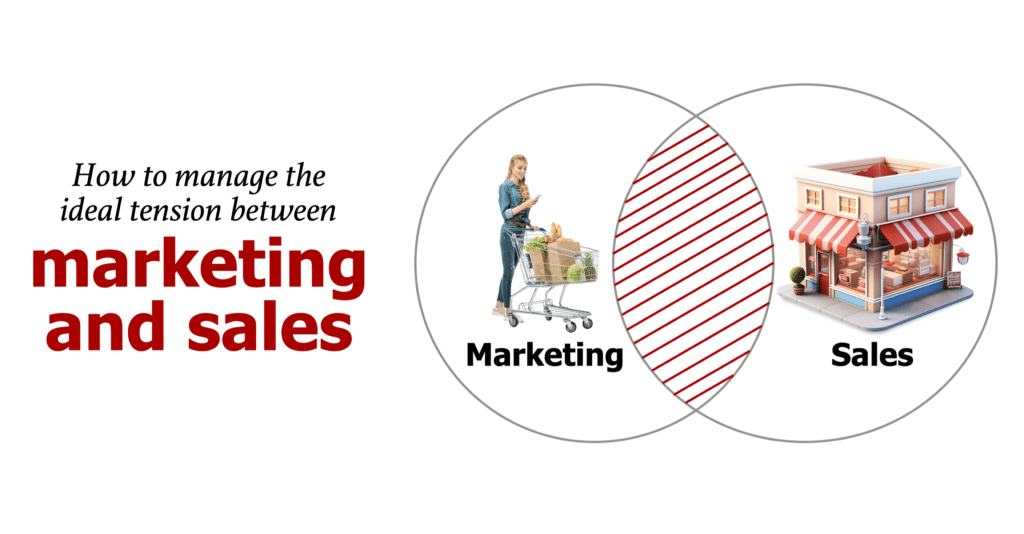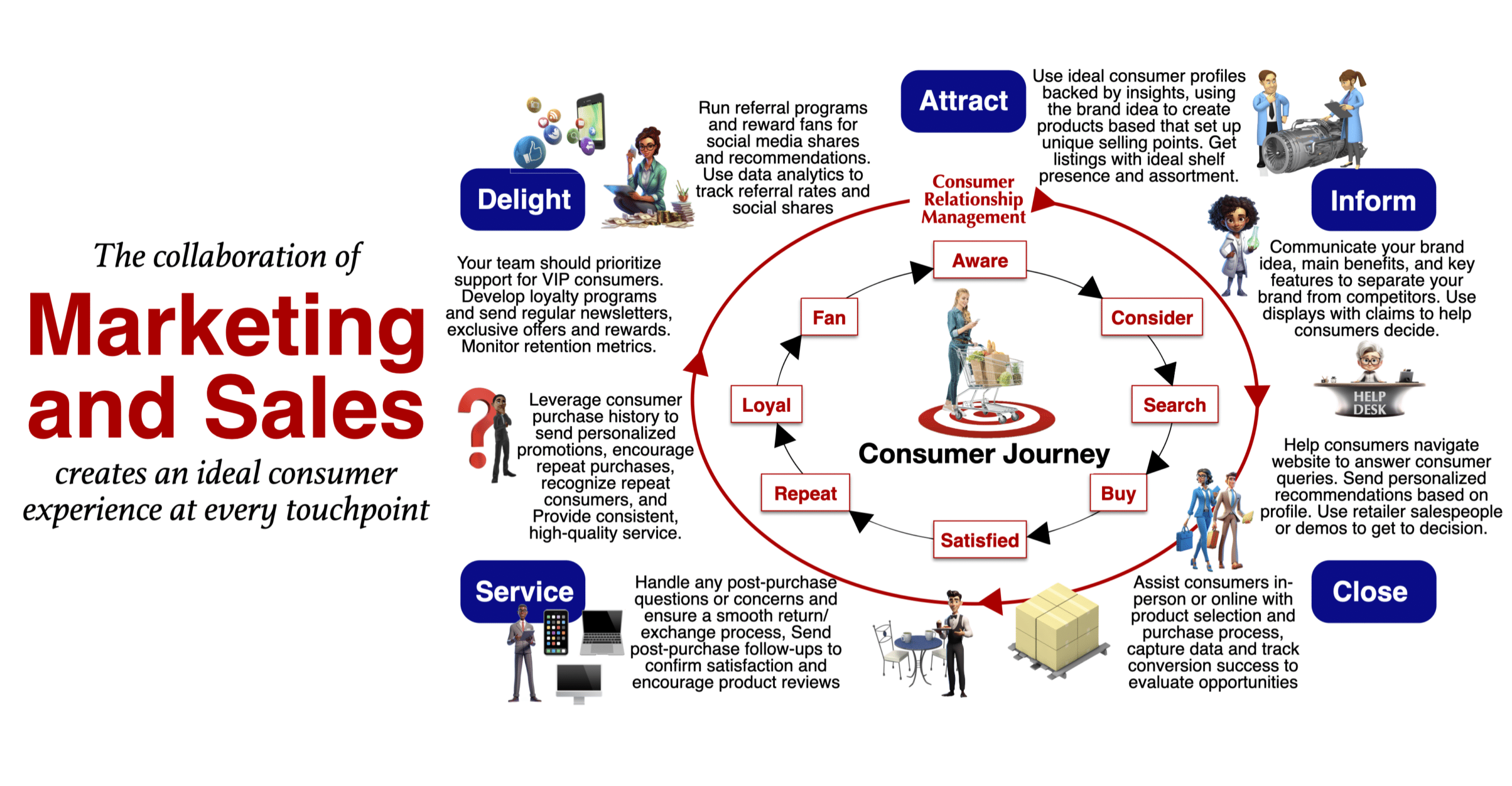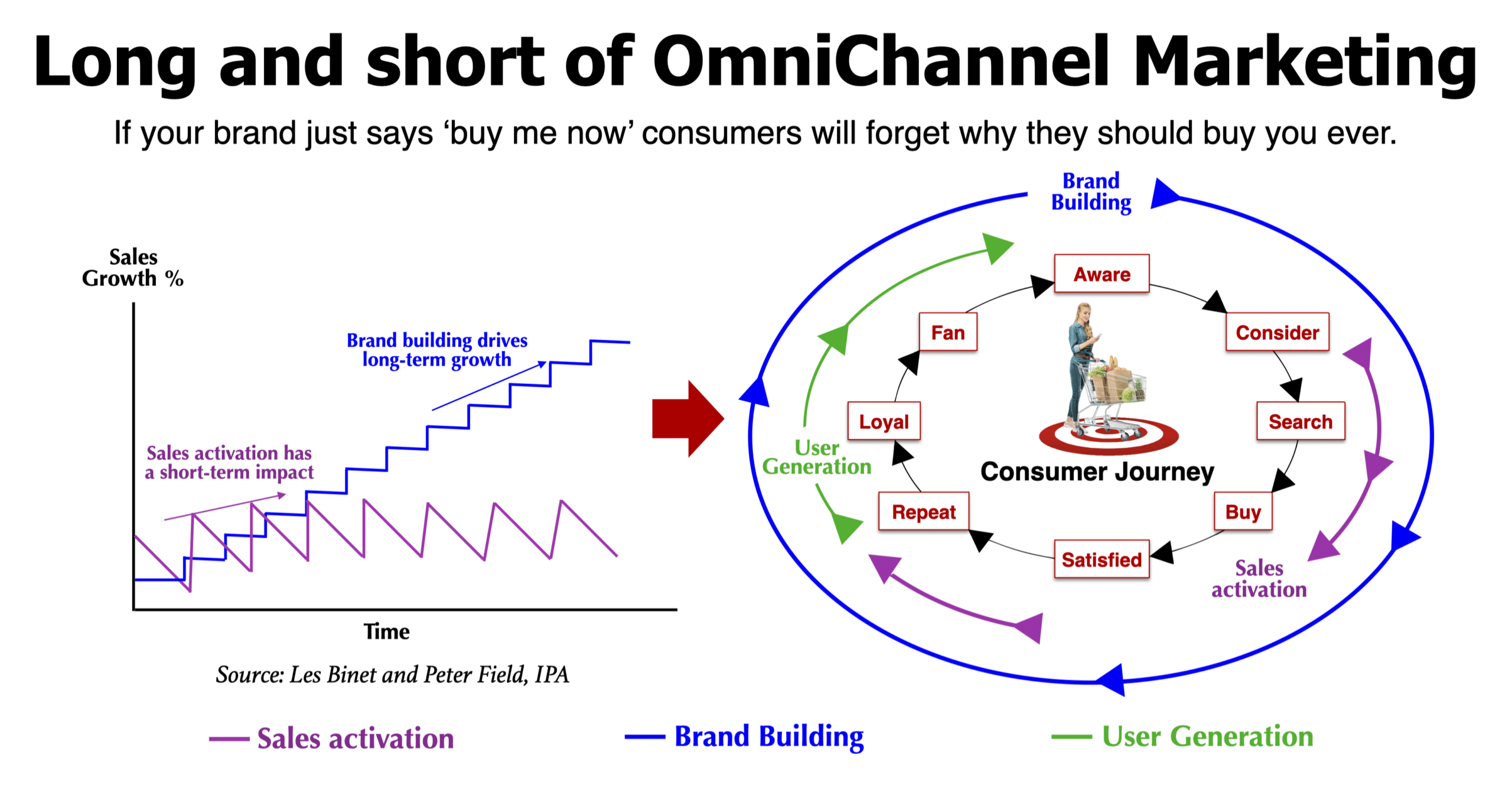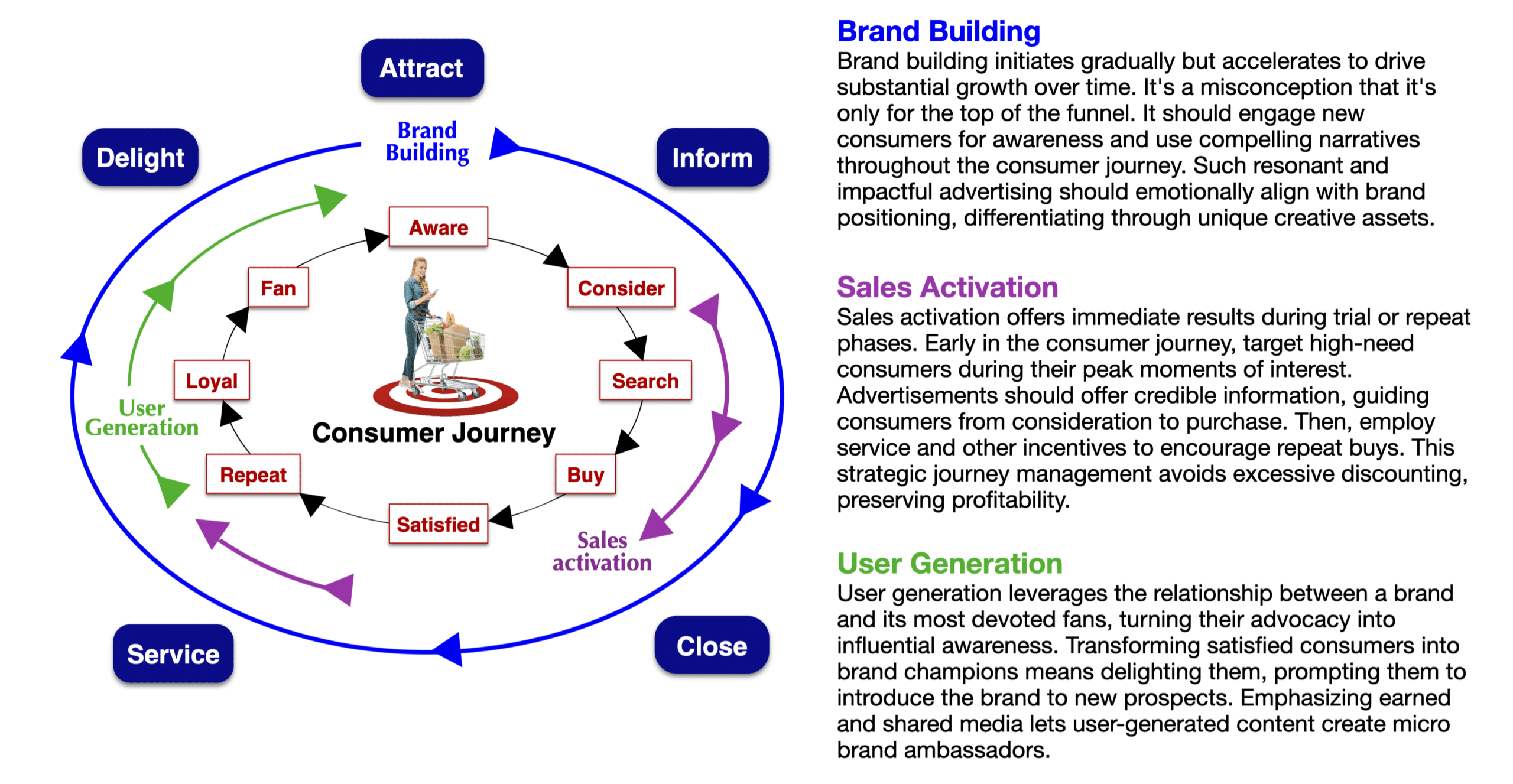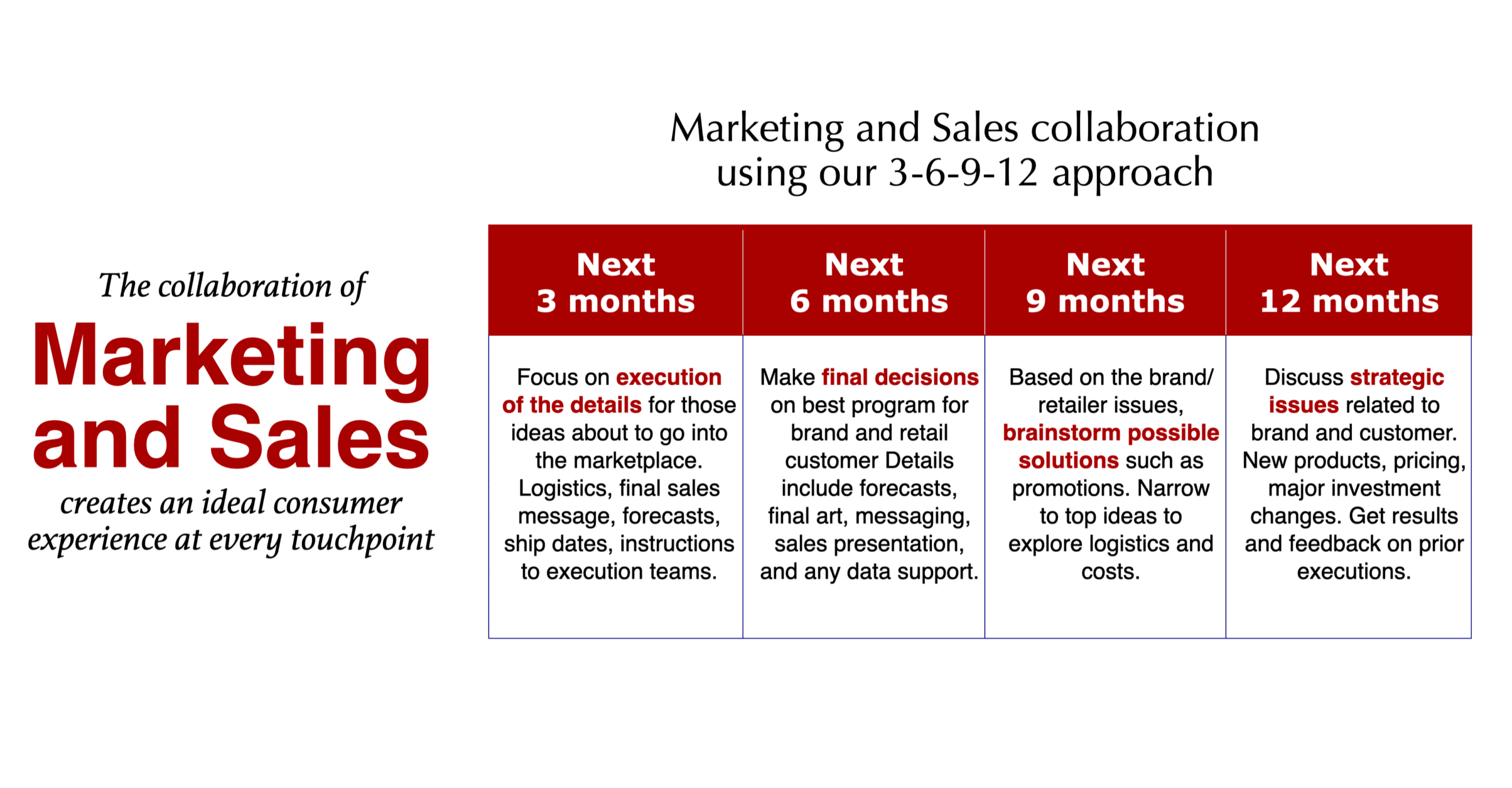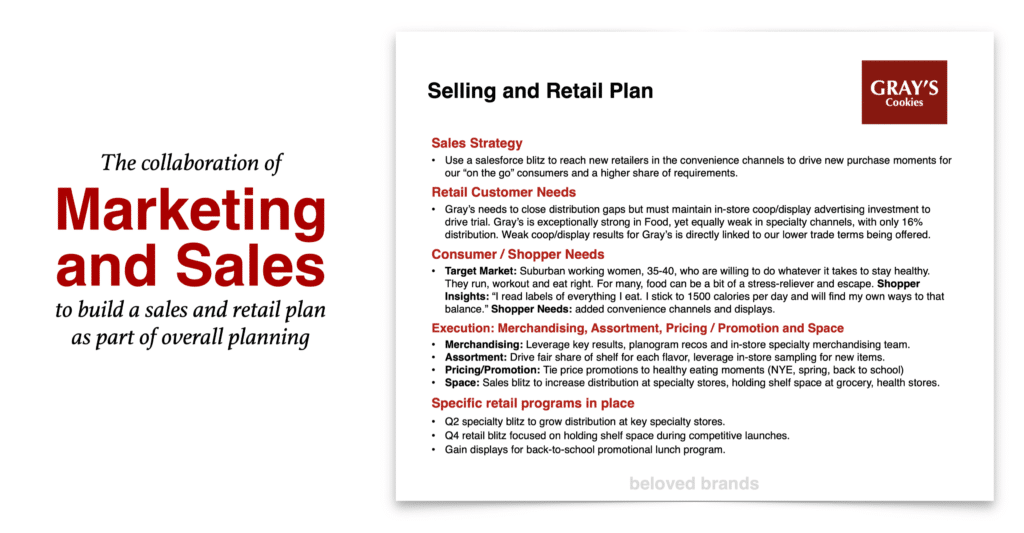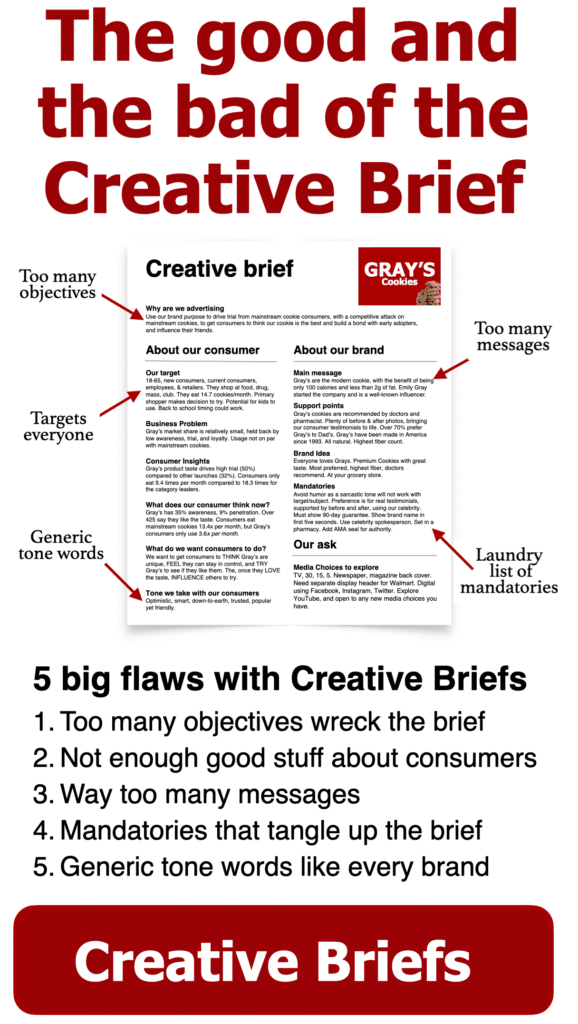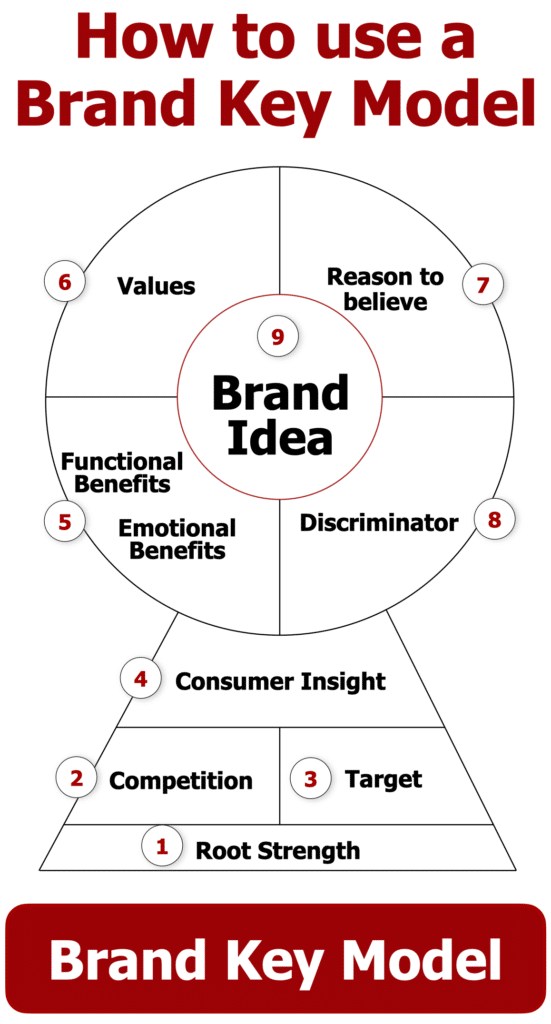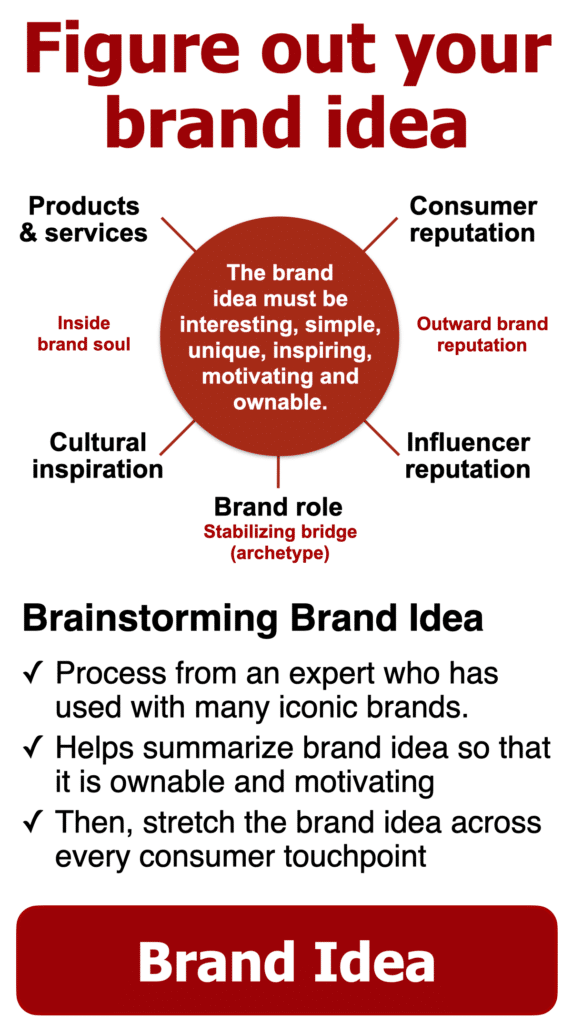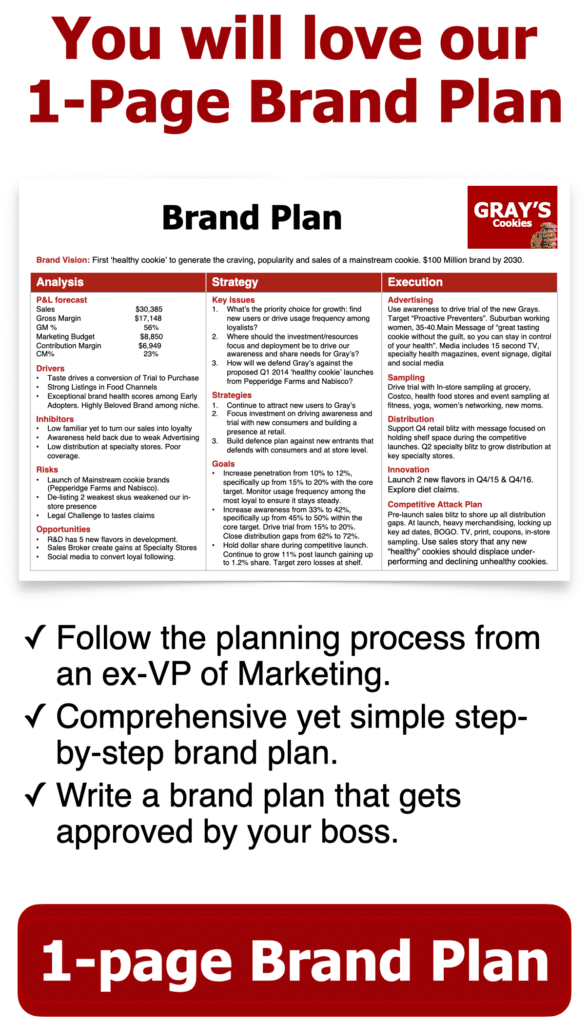There is a natural tension between marketing and sales due to their differing primary focuses, but that tension can be channeled productively. The yin and yang. A little tension and conflict is good when it is the starting point for collaboration.
The tension between marketing and sales arises when different objectives seem to pull the teams in separate directions. For instance, a marketer might focus solely on driving awareness without immediately focusing on sales conversion. Meanwhile, the sales team might feel the pressure of meeting this month’s sales targets, so they push for a discount or promotion that will trigger a sale. Hopefully, these are the extreme examples.
When the tension between marketing and sales is understood and managed correctly, it can lead to more robust strategies. A marketer is focused on the immediate and long-term, while salespeople focus on the short to intermediate. In marketing, most things are negotiable. While in sales, most are negotiated.
In a house of brands, a marketer will be focused on one brand sold through many retail customers. The sales leader focuses on one customer but sells many of the company’s brands. When the relationship breaks, the marketer believes the power of their brand matters more than any one partner customer. Or the salesperson believes the needs of their customer matter more.
While we want each side to do their job, there must be trust in what each other is doing. Where there is overlap, listen, debate, and resolve.
The difference between marketing and sales
Marketing often needs a broader, using an intermediate to long-term perspective. Brand managers want to establish a brand reputation using advertising with messaging aligned to their brand positioning. They know consumers must think to understand the brand before they can act. Marketers want to create desire, build a consumer bond, and drive penetration to increase market share. They focus on using marketing communications, launching product innovation, and creating the ideal consumer experience.
The sales team operates with a more immediate, short-term perspective. Sales leaders prioritize building customer relationships with their buyers. Their primary role is to generate revenue from their specific customers within defined periods. They often require a deep understanding of their buyer’s individual needs, preferences, and pain points. While brand reputation can influence decisions, sales leaders understand that the final push often comes from a trigger that uses the ideal merchandising, assortment, pricing, and promotions.
To illustrate, you can click on the diagram to see how Marketing and Sales must do their own part.
The diagram above shows how the marketer must manage all touchpoints along the consumer journey: aware, consider, search, buy, satisfied, repeat loyal, and fan that can create new awareness. To go deeper into how today’s marketer uses an OmniChannel marketing approach to manage the consumer journey, click here: Managing the consumer journey.
The salesperson manages all touchpoints of the selling journey following the push to get listed with a customer. The salesperson then focuses on assortment, merchandising, pricing, promotions, forecasting, and analysis, leading to a renegotiation that can create further listings.
Sales
How the salespeople manage the selling journey.
Listing:
Getting the products listed at key retailers is the starting point to make them visible and available to consumers, be it on an online platform or in-store.
- Proof of concept: Before approaching retailers, it’s imperative to have proof of concept backed up by market research that proves the product’s viability. Showcase the brand’s uniqueness and its potential to fill a gap in the market so the retailer sees how your brand will help them grow their category.
- Relationship matters: While the brand can provide all the necessary data and marketing materials, the finesse with which the salesperson’s relationship with the retailer, understanding of the retail space, and ability to negotiate are pivotal.
- Early support drives early success: Once a retailer agrees to list the product, to drive early success, it’s crucial to have marketing and promotional activities in place to support the launch.
Assortment:
Optimizing assortment requires brand and retailer collaboration, balancing between offering variety without overwhelming the consumer or straining the supply chain. An optimal assortment enhances the shopping experience and maximizes sales and profitability for both the brand and the retailer.
- Consumer/Retailer Dynamic: Marketing and sales must understand the consumer preferences specific to each retailer, analyzing the buying behavior, preferences, and demographic data of the consumers who frequently shop at a particular retailer or channel.
- Breadth vs. Depth: Decide on the assortment’s breadth (variety of different items) and depth (number of each item). While a broader assortment offers more choices, it might lead to inventory management challenges. A deeper assortment ensures availability for a fast-moving item but might limit variety.
- Product Hierarchy: Understand which products are core to the brand and ensure they are prominently featured. On the other hand, more niche or experimental products might be introduced gradually or in limited quantities.
- Planogram Design: Collaborate with the retailer to design a planogram that ensures maximum visibility for the products. Consider the shelf space, product placement, and visual appeal. Products should be organized in a manner that’s intuitive and appealing to consumers.
Merchandising:
The art and science of presenting the products stimulate interest and entice consumers to make a purchase. With a crowded store and cluttered shelves, the brand must stand out to drive consideration at the moment of truth. Effective in-store merchandising is about creating an immersive, engaging, and informative experience for the consumer. The goal is not just to attract attention but to convert that attention into a purchase by providing value and an emotional connection to the brand and its products.
- Visual Appeal: whether it’s a window or end-of-aisle display, take advantage of the opportunity to showcase the launches, best-selling SKUs, promotional items, or impulse items.
- Interactive Displays: For brands at a higher risk or complex, consumers want more information before they buy. Use signage to highlight the benefits of a product or range of products. Consider touch-and-feel displays, sampling opportunities, or even augmented reality to enhance user interaction.
- Understand the shopper: Line up your merchandising to how customers shop, best sellers or new products at eye level, and impulse items near the checkout area.
- Thematic Displays: Group products that go well together to tell a story or suggest a theme, such as “Summer Getaway” or “Back-to-School”.
Pricing:
While many marketers think of price as a defensive response to inflation or a competitive reaction at the retail shelf, the smartest brand leaders use price as a weapon to significantly enhance a brand’s reputation, market share, and profitability. Smart brand leaders weave pricing strategies seamlessly into their broader brand narratives and objectives, ensuring that price serves both a functional and strategic role.
- Price-Quality Inference: Consumers often use price as an indicator of quality. A higher price can create an expectation of better quality, durability, or even prestige. For the brand, it needs to deliver against those raised expectations to a skeptical consumer.
- Positioning Through Price: Brands can position themselves as premium, mid-tier, or budget based on their pricing strategy. Luxury brands, for instance, often use a high price point to signal exclusivity and superior quality.
- Good, better, best: Provides a range of product or service options to cater to different customer segments and budget levels. Allows a brand to cater to a broader audience, from budget-conscious to premium-seeking consumers. And it encourages trading up, as customers can clearly see the value proposition of each tier. There is a risk of confusion of value, as consumers doubt one brand can cater to each tier.
- Penetration vs. Skimming: A penetration pricing strategy sets a lower initial price to gain market share quickly. Alternatively, for a significant product advancement in the category, price skimming starts at a higher price and gradually lowers it. This allows the brand to recover R&D costs quickly and then target broader market segments.
Promotions
Marketing and sales can use promotional tactics to drive traffic, increase sales, and strengthen the relationship between the brand and the retailer.
- Exclusive Content or Experiences: Provide retail customers access to brand-centric events, webinars, workshops, or exclusive digital content. These value-added experiences can deepen engagement between the retailer and consumers, reinforce brand values, and enhance brand loyalty.
- Loyalty Programs: Implement a rewards system where consumers earn points for purchases, which can be redeemed for exclusive products, experiences, or perks. This encourages repeat purchases and fosters brand loyalty.
- Sampling and Demonstrations: Allows consumers to experience the product firsthand through free samples, in-store demonstrations, or trial periods. It provides consumers with a risk-free way to engage with the brand and can increase sales.
Forecasting and Analytics:
The dreaded forecasting that both marketing and sales tend to despise. But it’s a necessity for running the brand. Most marketers are not very good at sales forecasting. They either overthink or, quite frankly, under-think the forecast. You must know your business: To be good at sales forecasting, the marketing and sales teams must know the underlying key performance indicators, comparing sales trends against future demand. Stay close to your sales team to hear the collection of details that will impact your sales forecast.
For marketing and sales to enhance their forecasting accuracy, they should:
- Integrate Data & Collaboration: A unified data source ensures both teams can access a single, integrated data source to avoid discrepancies. Hold routine meetings to align on market trends, customer feedback, promotional results, and any anomalies spotted in sales data. Sales should provide real-time feedback to marketing about on-ground realities, while marketing can offer insights from broader market research and analytics.
- Utilize Advanced Analytics and tools: Use past sales data to identify patterns, seasonality, and growth rates. Implement predictive analytics tools that factor in both internal data (like past sales, promotions, or product launches) and external data (like market trends, economic indicators, or competitor activities). Regularly run different scenarios (best case, worst case, and most likely) to be prepared for various outcomes.
- Continuous Monitoring & Adjustment: Track sales in real-time to quickly spot and react to deviations from the forecast. Use monthly reviews and adjust forecasts based on actual sales outcomes, changing market conditions, or new information. After significant campaigns or the end of a quarter/year, analyze where forecasts were accurate and where they weren’t, and understand why to improve future forecasting efforts.
Renegotiate:
Based on the analysis, you might find areas where cost savings are possible or where terms need adjustment to suit the business’s needs better. By effectively renegotiating terms, businesses can optimize costs, enhance partnerships, and better align with their strategic objectives.
- Preparation and Research: Understand the current market rates and terms. Re-evaluate your business’s needs and constraints. Recognize the areas where the previous terms no longer align with the business goals.
- Open Communication: Sales will want to approach the retailer, wanting a win-win outcome. Clearly articulate the reasons for renegotiation, using your brand’s external market changes and momentum. Be prepared to compromise and find the middle ground. Consider alternative solutions or terms that might be beneficial to both parties.
- Maintain Relationship: The salesperson needs to focus on the relationship with the retail customer and will want to approach the conversation collaboratively rather than confrontationally.
M A R K E T I N G B O O K
beloved brands
The playbook for how to create a brand your consumers will love
Beloved Brands is your secret weapon to guide you through every challenge that you face in managing your brand
Get ready to challenge your mind as we take you on a deep dive to find the most thought-provoking strategic thinking questions that will help you see your brand in a whole new light.
Our unique process for defining your brand positioning will push you to find fresh ideas and new possibilities for how to differentiate your brand based on both functional and emotional benefits.
But we won’t just leave you with ideas – we show how to transform your thinking into action.
Learn how to write a brand plan that everyone can follow, ensuring that all stakeholders are aligned and contributing to your brand’s success.
We’ll walk you through the marketing execution process, from writing an inspiring brief to making smart and breakthrough decisions on both creative advertising and innovation.
And when it comes to analyzing your brand’s performance, we’ve got you covered. Learn how to conduct a dive deep audit on your brand to uncover key issues that you never knew existed.
And, don't just take our word for it: our Amazon reviews speak for themselves.
With over 85% of our customers giving us a glowing five-star rating and an overall rating of 4.8 out of 5.0, we know we’re doing something right. And with numerous weeks as the #1 bestseller in brand management, you can trust that we have the experience and expertise to help you achieve success.
"The cheat code for brand managers!"
“It is without a doubt the most practical book for those who want to follow brand management that I have ever read in my life! Beloved Brands is written by a real, experienced marketeer for marketers. This book contains methodologies, tools, templates and thought processes that Graham actually used and uses in his career.”
Read our sample chapter on strategic thinking
Marketing and Sales Collaboration
The collaboration of Marketing and Sales creates an ideal consumer experience at every touchpoint along the consumer’s journey as we attract, inform, close the deal, service, and delight our most loyal brand fans.
To illustrate, you can click on the diagram to see how Marketing and Sales work together.
The harmonious collaboration between Marketing and Sales is pivotal to offering a seamless and enriching consumer experience.
Here’s a breakdown of their intertwined roles across the consumer’s journey:
Attract:
Marketing creates brand awareness through advertising, social media, content marketing, and public relations. Use ideal consumer profiles backed by pain points and consumer insights, using the brand idea to create products that set up unique selling points based on product features. Sales gain retail listings and planogram support, giving the brand ideal in-store visibility.
Marketing and sales collaboration involves sharing insights on customer behavior and preferences. Sales can provide feedback from the ground, and Marketing can adjust strategies accordingly. Tension can get unruly when there is disagreement on the target audience or the methods to reach them. Marketing might prioritize longer-term brand reputation, while Sales might push for immediate transaction tactics.
To illustrate, you can click on the diagram to see how Marketing and Sales drive the long and short.
I'm a big believer in the balance of the long and short.
I like to use brand-building anthemic advertising to establish brand positioning, create an emotional connection with your target audience, strengthen brand identity, and foster consumer loyalty.
Brand-building establishes a sustainable competitive advantage and brand love, which translates to increased sales growth, market share, and profitability over time.
Short-term transactional advertising pushes for immediate results, such as boosting sales, increasing website traffic, or generating leads. These campaigns often leverage desires and impulses, promotions, discounts, or limited-time offers to create a sense of urgency and drive quick consumer actions. Read more on the long and short that OmniChannel Marketing can help drive.
To illustrate, you can click on the diagram to see how Marketing and Sales drive the long and short.
Inform:
Marketing provides valuable content that educates the consumer, such as blog posts, webinars, and informative videos. Ensure all employees understand and can communicate your brand idea, main benefits, and key features to separate your brand from competitors.
Sales can negotiate with their retail customers to gain product demos and personalized consultations to answer specific queries and further inform potential consumers.
Marketing and Sales collaboration happens best when Sales provide insights into their retail customer strategies and how Marketing can produce content to match up and take advantage of programs the retailer is investing in. Tension will when the Marketing content doesn’t align with the retail customer’s strategy.
Close the Deal:
Marketing can help by using packaging that stands out on the shelf, using brand messaging and product claims at the moment of truth, and special offers that will trigger the sale. They can use remarketing strategies for online sales to push consumers closer to purchase. The sales team can work to make sure everything on the shelf is in good shape.
The best marketing and sales collaboration happens with regular feedback loops. Tension gets out of control when marketing and sales can’t agree, and sloppy, confusing execution hits the market.
3-6-9-12 planning
The worst marketers try to ram their ideas through sales, expecting them to follow your orders. Come up with ideas together. I recommend having quarterly meetings between sales and marketing with a collaborative look at the next 3 months, the next 6 months, the next 9 months, and the next 12 months focused on merchandising, assortment, promotions, and your brand’s shelf space.
To illustrate, you can click on the diagram to see how Marketing and Sales work together.
Service:
Marketing engages consumers post-purchase through educational content, feedback solicitations, and loyalty programs. Sales must work with retail partners to analyze the performance and drive added promotions that can drive repeat purchases and build a routine.
Ideal collaboration happens when marketing and sales use coordinated after-sales touchpoints. Marketing can engage with content, while Sales can offer promotions that can trigger a repeat purchase. The tension can get out of control when there are differing post-purchase strategies. Sales might want to upsell immediately, while Marketing might want to engage with long-term and educational content first.
Delight:
Marketing should prioritize support for VIP consumers. Develop loyalty programs and send regular newsletters, exclusive offers, and rewards. Monitor retention metrics. Run referral programs and reward fans for social media shares and recommendations. Use data analytics to track referral rates and social shares. Marketing and Sales will win when they use shared customer relationship management (CRM) strategies. By working from the same data and coordinating outreach, both teams can ensure customers receive timely and relevant communication. Tension will happen if marketing overwhelms or annoys the customer’s consumer.
When Marketing and Sales function symbiotically, they ensure a unified brand message and a consistent experience, transforming casual consumers into brand ambassadors. This not only maximizes immediate sales opportunities but also fosters long-term brand loyalty.
We recommend taking this thinking and building a Selling and Retail Plan as part of your overall marketing planning process.
To illustrate, you can click on the diagram to see how Marketing and Sales work together.
Our brand toolkit for consumer brands is our most comprehensive template helps you communicate your brand plans, brand positioning, business review and creative briefs.
Our brand plan template offers slides for vision, purpose, analysis, key issues, strategies, and execution plans, ensuring a thorough approach to your brand’s development. The brand positioning template guides you through defining your target profile, crafting a brand positioning statement, and developing a unique brand idea, concept, values, story, credo, and creative brief. Finally, our business review template provides slides for in-depth analysis of the marketplace, customers, competitors, channels, and your brand.
Choose the right template for your business needs
Marketing Plans for consumer brands
Combining strategic slides for insightful planning and marketing execution slides for seamless implementation, our templates are designed to propel your brand towards success and help you make a lasting impact in the market.


